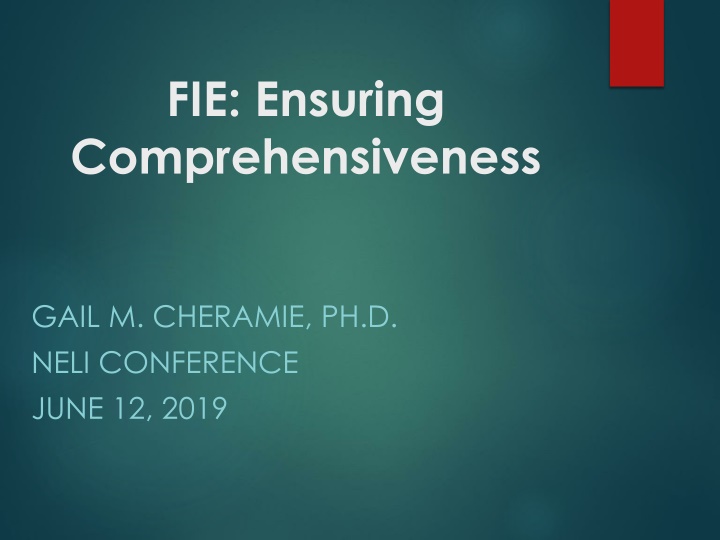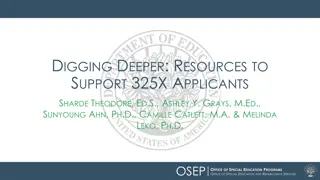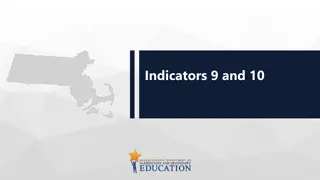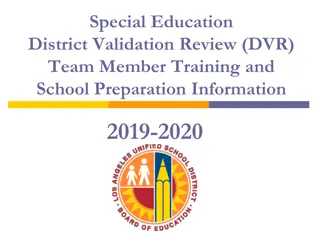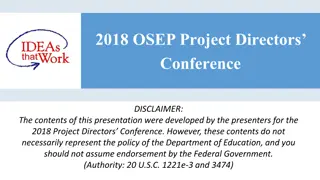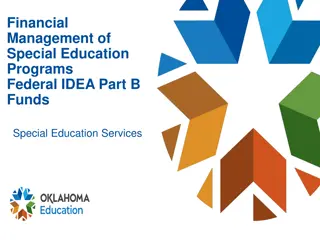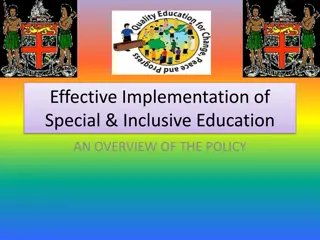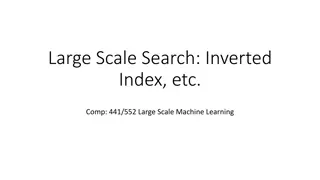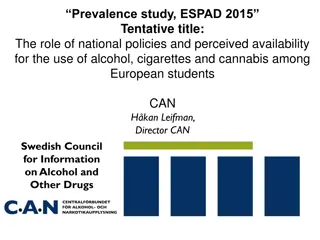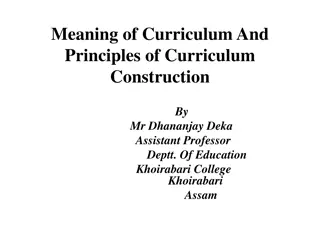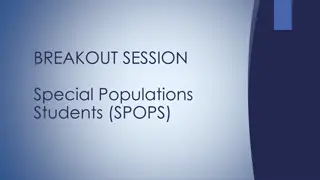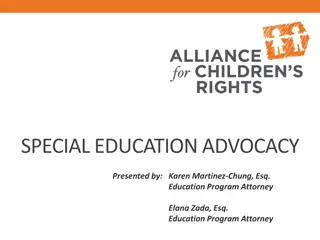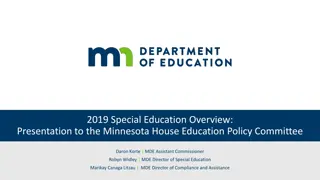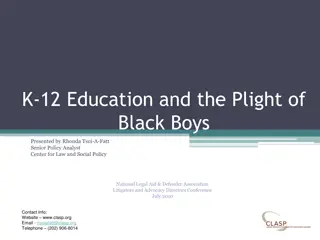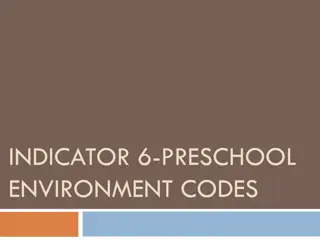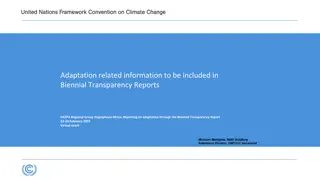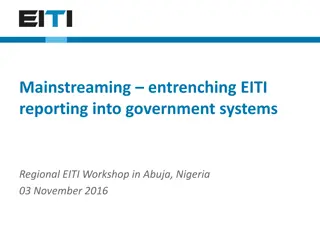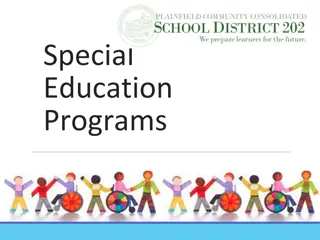Challenges and Impact of Ensuring Comprehensiveness in Special Education Programs
The content discusses the challenges faced in ensuring comprehensive special education services, highlighting a series of articles on Texas' special education system. It reveals an increase in referrals and FIE evaluations, leading to concerns about the quality of assessments and possible loss of public trust. Strategies to manage referrals and FIEs are suggested to navigate the evolving landscape of special education services.
Download Presentation

Please find below an Image/Link to download the presentation.
The content on the website is provided AS IS for your information and personal use only. It may not be sold, licensed, or shared on other websites without obtaining consent from the author.If you encounter any issues during the download, it is possible that the publisher has removed the file from their server.
You are allowed to download the files provided on this website for personal or commercial use, subject to the condition that they are used lawfully. All files are the property of their respective owners.
The content on the website is provided AS IS for your information and personal use only. It may not be sold, licensed, or shared on other websites without obtaining consent from the author.
E N D
Presentation Transcript
FIE: Ensuring Comprehensiveness GAIL M. CHERAMIE, PH.D. NELI CONFERENCE JUNE 12, 2019
A brief history or How the ___ did we get in this mess? Houston Chronicle publishes a 7-part series of articles (Fall 2016). First article: Denied: How Texas keeps tens of thousands of children out of special education Article exposes cap of 8.5% and says Texas forced districts to comply; Rosenthal was told by an advocate about the cap Rosenthal and Chronicle have won several awards (finalist for Pulitzer in public service); now at New York Times; left in Spring 2017
Outcome: How the cap leads to CAP OSEP visits Texas and finds 3 major IDEA violations: Locate and identify FAPE Supervisory and Monitoring April 23, 2018 TEA Strategic Plan; has 5 components: State Monitoring Identification, Evaluation, and Offer of FAPE Training, Support, and Development Student, Family, and Community Engagement Technical Assistance Networks and Structures
So how has this affected us? Increase in initial referrals compared to last year Large districts: +249 Fall 18 vs. Fall 17; 60% increase; approximately +86/month more versus last year Medium to small districts: 23/month versus 52/month; +77 Fall 2018 vs. Fall 2017 Counts at end of Spring 2019: Large districts: 2900- 3700; medium district: 1200; small district: 400 referrals, 285 initials Are we denying FIEs? NO = a significant increase in FIEs Not enough people to evaluate Contract evaluators, service providers, Testing on Saturdays, holidays,
Net Effect Frustrated, some ridiculous referrals Feeling pressure to test and to qualify Some components of FIE changing e.g., Dyslexia and Dysgraphia part of FIEs More Advocates and Attorneys Total Net Effect = Loss of Public Trust In this climate, we need to be careful that this has not adversely affected the quality of our FIEs.
Can we cut down on FIE? Due to large number of referrals, one approach is to cut down on the FIE Consider Issues/Complications If DNQ, evaluation will be questioned If Q, but not in the area or all areas wanted, evaluation will be questioned If eligible, compensatory services may be discussed Dyslexia and Dysgraphia Parent referrals Students receiving 504 have already been identified with a disability, so lack of FIEs will be scrutinized regarding this group
Pitfall? A hidden or unexpected or not easily recognized danger or difficulty Risk Trap A likely mistake or problem in a situation
SCOPE Scope refers to extent/range/breadth One major purpose of the FIE is to determine if the student has a disability, thus IDEA requires that the student be assessed in all areas of suspected disability An evaluation of sufficient scope should address all areas of suspected disability for purposes of disability determination Remember, for some of our categories, we must rule other things out And not just disability condition, the FIE has to be sufficiently comprehensive to identify all of the child s special education and related services needs
SCOPE=COMPREHENSIVENESS This has also been interpreted as not only breadth, but also depth of assessment How thorough and detailed is the FIE? Thoroughness did we leave something out (e.g., observation) did we only use one method (e.g., a behavior rating scale or checklist) should we have done additional assessment (e.g., FBA, Social Skills)
A few recent cases that address Scope Lawrence County School District Arkansas (2018) Student diagnosed with ADHD and Autism served under 504; performed well academically; parent requested evaluation but denied due to good grades and honors recognitions; but had behaviors such as tantrums, spinning in circles, pulling hair out. Hearing officer ordered an evaluation; district appealed and court affirmed the decision. Evaluation is not same as providing special education services Conejo Valley USD California (2018) Student with ED. Failure to conduct FBA as part of initial evaluation. Aggressive behaviors. Compensatory services plus those of 1-1 aide awarded.
A few recent cases that address Scope Rose Tree Media School District Pennsylvania (2019) OHI, ED. Did not evaluate in all areas of suspected disability. 2019 Houston ISD. FIE met requirements overall, but should have done the following: Speech evaluation for Pragmatics, Social Skills assessment, and FBA
2 Major Factors leading to Problems with SCOPE REASON FOR REFERRAL ALL AREAS OF SUSPECTED DISABILITY Referral denotes a problem; Evaluation determines all areas of suspected disability Could have been referred for a specific problem or a general issue, but evaluation is dynamic (characterized by change, activity; process is fluid; changes as data are gathered) TIMELINES
Example: John Doe 6th grade; KABC-II KABC-II Sequential=91 Gsm NumRecall=9 Word Order=8 KABC-II Simultaneous=97 Gv Rover=12, Triangles=6, Block Counting=7 KABC-II Learning=94 Glr Atlantis=9, Rebus=9 KABC-II Planning=93 Gf PatternReas=10, StoryCompletion=8 KABC-II Knowledge=97 Gc VerbKnow=10, Riddles=9 KABC-II FCI = 93
John Doe Additional testing CTOPP-2=79 Ga Elision=5, Blending=7, Phoneme Isolation=6 WISC-V PSI=88 Gs CD=7, SS=9 KTEA-3 (5 subtests were administered) LW RECOG=79 READ COMP=80 (low score primarily due to lack of ability to read many words in the passages) WRITTEN EXPRESSION=84 (handwriting is age- appropriate; able to construct sentences; problem is primarily in spelling) MATH CONC & APPLIC = 88 MATH COMPUTATION = 94
John Doe In this case, much testing was done. All G s are complete and there are tests in each academic domain. Testing sufficient for LD in Basic Reading. But since LD in Basic Reading, we also need to address Dyslexia. If we apply these data to the Dyslexia Handbook, we are missing several things: Nonsense Word Decoding Spelling Reading Fluency Rapid Naming
Breadth To broaden the scope of the FIE to include another suspected area of disability The best way to avoid this pitfall is to follow the RIOT model and to analyze data as it is collected. The RIO in RIOT will lead to thorough data gathering. Suspected disabilities could come up in educational records, RtI documents, parent forms, 504 documents, interviews with the parent, interviews with the teacher, and your direct observations of the student. The T in RIOT refers to tests, and results obtained may lead to additional areas of suspected disabilities.
RIOT Review of Records, including previous evaluations Interviews Observations Tests RIOT will assist in addressing Scope
2 Issues: Domains to Assess& Methods of Assessment Domains: Sociological Speech-Language-Communication Physical-Motor-Health Social-Emotional-Behavioral Cognitive Adaptive Behavior Academic Assistive Technology Methods: RIOT
R I O T Sociological Speech-Lang-Communication Physical-Motor-Health Emotional-Behavioral-Social Cognitive Adaptive Behavior Academic Performance Assistive Technology
Depth In addition to expanding the scope of the evaluation to address additional suspected disabilities, each of the Domains to assess should also be expanded when needed. Example: the initial information did not suggest a speech-language issue so review of records and checklist from the teacher were sufficient. But testing shows low language skills, parent reports in the interview that student is being seen by a private speech therapist, etc. Example: the initial information was about speech only, but data gathered indicates that the student may be ID. While we would address all FIE areas in all initial evaluations, now areas such as intellectual and adaptive behavior need to be expanded.
Evaluators need to be knowledgeable about: Multiple disability categories Basic Reading and Dyslexia, Written Expression and Dysgraphia, OHI and ED, LD and ADHD, ID and AU, Patterns of behavior that may signify the presence of an additional condition (e.g. ADHD) Concerns expressed by the parent and teacher (our forms do not capture this well) Multifaceted nature of tests and rating scales (we must interpret better to ensure depth of evaluation)
REVIEW OF RECORDS Review of Previous Evaluations done by your district, other districts, and private providers Review of medical history Review of Data in School Records (this is not usually the problem, as school records are typically embedded throughout the FIE) This review should be thorough; sets the history; sets the context; can be used to confirm the presence of a disorder or to support differential
INTERVIEWS These are likely omissions in the FIE and usually involve 3 areas: Parent Interview Teacher Interview Interview with External providers Lack of interviews, especially follow-up interviews, can affect the validity of your evaluation Don t forget student interview!
2 Major Factors in Lack of Interview Data OVERRELIANCE ON PARENT AND TEACHER INFORMATION FORMS These forms are usually good, but lack comprehensiveness and do not afford the opportunity for explanations OVERRELIANCE ON RATING SCALES OR CHECKLISTS Scales and checklists are integral parts of the evaluation, but do not offer the opportunity for follow-up and explanations of ratings
We need to: Conduct a face-to-face interview with the parent If not possible, review information provided on parent information form and conduct a phone interview Conduct a face-to-face interview with teachers Conduct a phone interview with external providers; if not possible, submit questions Remember, need consent/release for this Review checklists/rating scales and then conduct follow-up interviews with parent and teachers for additional information/examples/clarification
Questions for External Providers How long have you been seeing/providing services to ___? How did ___ get referred to you? What types of services is ___ receiving? How often do you see ___? Length of sessions? What diagnoses are identified for ___? Did you conduct a formal evaluation of ___? Do you have a copy of the report? Can you provide us with that? Based on your involvement with ___, what are his/her strengths? weaknesses?
Example The BASC-3 F Index is a scale designed to assess the probability a rater has depicted a children s behavior in an inordinately negative fashion. This index consists of items that represent maladaptive behaviors to which the rater answered almost always and adaptive behaviors to which the rater responded never. The F index produced from the ratings of _____ s behavior by his teacher and parent falls within the Caution to Extreme Caution range, which may indicate the presence of negative response distortion. Fewer than 5% of children in the general population receive scores in this range and caution should be used when interpreting these results. Too often the narrative ends here and then interpretation follows. This leaves the question of validity open and goes beyond a simple omission of information.
But in this case, follow-up was conducted Guidance from the BASC-3 Manual indicates that careful corroboration of these ratings should be based on additional sources of information. Follow- up interviews were conducted with the parent and teacher, item ratings were clarified and specific examples were provided to confirm the ratings. Thus the BASC-3 is considered a valid representation of ___ s behavioral characteristics based on the concerns of both the parent and teacher.
OBSERVATIONS Observations must be done in area of suspected disability for LD Purpose is complex: To describe behavior To describe student s skills in the academic area To relate behavior and academics and, in many cases, rule out behavior as a primary cause of academic deficits Type of observation needs to match the purpose Often observations are only a checklist about behaviors
Factors leading to Problems w/ Observations OVERRELIANCE ON A LIMITED STANDARD CHECKLIST OFTEN DONE BY SCHOOL PERSONNEL WHO ARE NOT EVALUATORS Overcoming this: Conduct the appropriate observation based on purpose and setting. Conduct different types of observations (e.g., narrative, time-sampling systematic).
TESTs Selection of instruments is important. Type of test may not be as comprehensive as you think; may not measure all the areas you need to assess. Need to ensure that multiple data sources are used and not just a test. Explanations of test performance or interpretations are: not present (e.g., a table but no interpretation, a screenshot but no explanation, ), not complete, or not clear Interpretation Hypotheses In some cases, our interpretations are not accurate (e.g., saying you have a G when you do not) Interpretation involves an analysis of data and also synthesis of multiple data sources
Hypotheses, Not Interpretation Low performance in the area may be due to limited knowledge of basic math facts or lack of automaticity. Scores low in oral reading may be a function of limited decoding skills, comprehension difficulties, or both, resulting in a lack of reading fluency. Individuals with expressive language impairments may struggle with the oral demands of this task. If you do not know why, then cannot make appropriate Recommendations.
INTEGRATION of DATA Integration of data usually involves several components: Multiple sources of data (parent, teacher, student) Multiple types of data (score on a standardized test, teacher and parent interviews, criterion-referenced testing, observations, work samples, grades, ) Ecological validity classroom performance, social behaviors, how does the deficit actually look in the classroom or school environment, how test performance is consistent with behavior/ performance/functioning in real-world setting When this is not done, the more potential for inconsistency or contradiction with the FIE
Some final thoughts on Scope (both breadth and depth) Will usually involve a dilemma- not sure what classification is appropriate cannot determine if student truly meets the criteria for a condition cannot effectively describe needs there are differences between parent and teacher ratings/descriptions the are differences among the data sets there is disagreement among the team Remember, FIEs answer questions they do not end with questions.
